 The three finalists for the fourth President’s Award for Endangered Crafts, established by Heritage Crafts President The Former Prince of Wales, have been announced.
The three finalists for the fourth President’s Award for Endangered Crafts, established by Heritage Crafts President The Former Prince of Wales, have been announced.
Each year the President’s Award presents £3,000 to the winning heritage craftsperson who will use the funding to ensure that craft skills are passed on to the future, with an additional £1,000 for runner-up bursaries provided by Patricia Lovett MBE and Kate Hobhouse.
The three finalists for 2023 are (in alphabetical order):
The winner will be announced at a prestigious Winners’ Reception at the Vicar’s Hall, St George’s House, Windsor Castle on 15 November 2023.
The finalists were selected by a panel of judges made up of renowned advocates of craft skills:
- Jay Blades MBE, Co-Chair of Heritage Crafts;
- Kate Hobhouse, Chair of Fortnum and Mason;
- Patricia Lovett MBE, former Chair of Heritage Crafts;
- Simon Sadinsky, Executive Director of The Prince’s Foundation; and
- Johanna Welsh, pargeter and 2022 President’s Award winner.
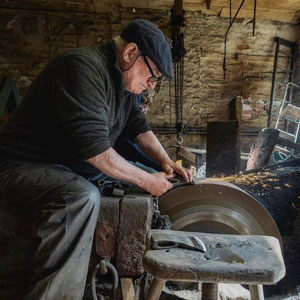 The family of the late master hand grinder Brian Alcock have received a posthumous British Empire Medal in the King’s Birthday Honours in recognition of his service to the Sheffield cutlery trade and heritage crafts.
The family of the late master hand grinder Brian Alcock have received a posthumous British Empire Medal in the King’s Birthday Honours in recognition of his service to the Sheffield cutlery trade and heritage crafts.
Brian, who passed away less than three weeks ago, was one of six makers nominated by Heritage Crafts to receive national honours, alongside clockmaker David Poole MBE, boatbuilder Ronald John Maclean MBE, blacksmithing trainer Delyth Done MBE, marbler and woodgrainer Robert Woodland MBE, and knitwear designer Jeanette Sloan BEM, in recognition of their unparalleled craftsmanship and tireless work in ensuring their skills are passed on to current and future generations.
The six were nominated for this year’s Birthday Honours, following 24 previously successful nominations from Heritage Crafts since 2013. In May, the charitable organisation – which was set up in 2009 to support and champion traditional craft skills – published the fourth edition of its groundbreaking Red List of Endangered Crafts, the only report of its kind to rank UK craft skills by the likelihood they will survive into the next generation.
Heritage Crafts was deeply saddened to learn of Brian Alcock BEM’s passing on 30 May. As a jobbing grinder working up to a week before his death, Brian was an unparalleled repository of knowledge and skill in the craft of hand grinding. He exemplified the honest work ethic of a skilled master craftsman, and even at the age of 81 he would work 40 hours a week, starting at 6.30am each morning through all four seasons. No job was too small for him; even putting an edge on a simple pocket knife was handled with the care and concentration of a man who relished the craft he had learnt so well.
What set Brian apart was how freely he shared his knowledge and skill. Five years ago founding Heritage Crafts Chair Robin Wood MBE was concerned that once Brian stopped he would have nobody to grind axes for his growing business, and that this important part of Sheffield’s cultural heritage could be lost. At this point Brian offered to train Robin’s apprentice Zak Wolstenholme. He had been passing his knowledge of how to grind tools and maintain the machinery to Zak, free of charge, right up until his passing. Zak admired him greatly and he had become a very significant life mentor.
Thankfully, Brian learned of his forthcoming honour before he died, knowing the esteem in which he was held. Our thoughts are with his family and friends at this time.
 David Poole MBE has been clock maker of the highest standard for over forty years. He has made critical contributions to horological education, establishing remote learning, support and examinations through the British Horological Institute and organising apprenticeships through the George Daniels Educational Trust. Between 2016 and 2019 David set up the Watchmakers Trailblazer Apprenticeship Scheme, one of the first of its kind under the government-backed initiative to promote craft apprenticeships, overcoming many obstacles with devotion and total service.
David Poole MBE has been clock maker of the highest standard for over forty years. He has made critical contributions to horological education, establishing remote learning, support and examinations through the British Horological Institute and organising apprenticeships through the George Daniels Educational Trust. Between 2016 and 2019 David set up the Watchmakers Trailblazer Apprenticeship Scheme, one of the first of its kind under the government-backed initiative to promote craft apprenticeships, overcoming many obstacles with devotion and total service.
Ronald John MacLean MBE represents an unbroken line of boat builders who, over 150 years, have provided as many as one thousand workboats to the island communities of the Hebrides. He has preserved an entire style of vernacular boat building (the Grimsay workboat of Scotland) through his craft skills, teaching and interpretation of the tradition. He has designed accredited courses in Traditional Boatbuilding Skills, and with his gifts as a teacher devised a curriculum to transmit the Grimsay boat tradition through Gaelic boatbuilding terminology.
Delyth Done MBE has been unparalleled throughout the past decade in ensuring that the next generation of blacksmiths have the high-level skills they need. As head of the blacksmithing degree programme at Hereford College of Arts for over ten years, she has been directly responsible for improving the training standards so that graduates are recognised and sought after as employees by master blacksmiths around the world.
Robert Woodland MBE is one of the most highly-skilled ornamental artists, woodgrainers and marblers in the UK today. His work can be seen in a variety of buildings across the country, including the Palace of Westminster, Buckingham Palace, the British Museum, the Tower of London, Grand Lodge, Harrods, Harvey Nichols, Kensington Palace, Bagshot Park and the Mandarin Hotel. Robert has a passion to keep his trade alive and shares his knowledge openly with students from around the world, enthusiastically demonstrating his craft whenever he has a chance.
Jeanette Sloan BEM is one of the most prominent and successful Black knitwear designers in the UK today, and has done a huge amount to promote and celebrate the contribution of Black, Indigenous and People of Colour (BIPOC) to British textile crafts. Among a career of achievements, she devoted her time and expertise, unpaid, to found the ‘BIPOC in Fibre’ project, to celebrate and raise awareness of the contribution of BIPOC to British textile design.
Heritage Crafts Executive Director Daniel Carpenter said:
“We are thrilled that six of our nominations have been recognised in this the first Birthday Honours of King Charles III’s reign. Having traditional craftspeople up there with other great luminaries of public life in this way is vitally important, as UK is still one of only 12 of the 193 UNESCO member states yet to ratify the 2003 Convention on the Safeguarding of Intangible Heritage.”
Heritage Crafts encourages anyone who supports the continuation of traditional craft skills, whether or not they are makers themselves, to become Heritage Crafts members via its website www.heritagecrafts.org.uk.
The charity has set up an Endangered Crafts Fund to provide small grants to projects that increase the likelihood of endangered craft skills surviving into the next generation, and is currently seeking donations to save more of Britain’s most endangered crafts from oblivion – visit www.heritagecrafts.org.uk/ecf to find out more and to donate

New research by Heritage Crafts has unearthed more traditional craft skills on the verge of extinction in the UK, in the latest major update of its pioneering project, the Red List of Endangered Crafts.
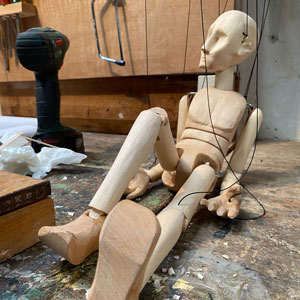
Oliver Hymans marionette maker
The research, which has been funded by The Pilgrim Trust with additional sponsorship from The Royal Mint, has found that the energy crisis and inflation has only exacerbated the issues faced by our most at-risk skills, building on the cumulative effect of COVID-19, continuing uncertainties around Brexit and structural issues relating to the funding for skills transmission.
Five new crafts have been added to the ‘critically endangered’ category of the Red List, meaning that they are at serious risk of dying out in the next generation, including straw hat making and encaustic tile making. They join the list of 146 at-risk crafts, including six that have been reclassified as being in greater danger than when the research was last updated in 2021, such as violin bow making and hat block making.
Critically endangered crafts include those with very few practitioners, few (if any) trainees and a lack of viable training routes by which the skills can be passed on. Often they serve very niche markets, and craftspeople cannot afford to step away from production to train their successors for fear those markets will disappear. New crafts in the ‘endangered’ category include Cornish hedging, marionette making and pigment making.
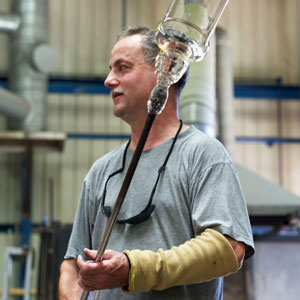
English Antique Glass Ltd
One craft has become extinct in the UK since the publication of the last edition. Mouth-blown flat glass was produced by English Antique Glass in Birmingham until 2022, at which point they were forced to stop production as a result of pressures to reduce their workshop space. This is one of the reasons that the making and restoration of historic stained glass windows has also been added to the Red List, demonstrating the knock-on effect losing one craft can have on others.
It’s not all bad news, however, as some crafts, such as brilliant cutting and shinty stick making, have seen an upturn in their fortunes and moved out of the ‘critically endangered’ category. In many cases this has been as a result of a new-found appreciation of the handmade and the need to support small businesses during the pandemic. In others it has been due to direct support from Heritage Crafts, which since the publication of the last edition of the Red List has distributed 57 grants of up to £2,000 each as part of its Endangered Crafts Fund.
Mary Lewis, who led the research on behalf of Heritage Crafts, said:
“The effect of the energy crisis, inflation, COVID-19 and Brexit have been tough on everyone, not least the craftspeople who possess our most fundamental craft skills. We know that heritage craft skills operate like an ecosystem; if we lose one part it can have devastating consequences on other parts of the system. If we allow endangered crafts to disappear then we seriously diminish the opportunities for future generations to create their own sustainable and fulfilling livelihoods and deal with the challenges of the future.”
Whilst the UK has been a world-leader in the preservation of tangible heritage (museum collections, buildings and monuments), it has fallen behind the rest of the world when it comes to the safeguarding of intangible heritage (knowledge, skills and practices). Of 193 UNESCO members, the UK is one of just 12 that have not yet ratified the 2003 Convention on the Safeguarding of Intangible Heritage, and government responsibility for heritage crafts falls in the gap between agencies set up to support arts and heritage.
Jay Blades MBE, Heritage Crafts Co-Chair said:
“When craft skills are in danger of dying out it’s important that we know exactly where to focus our efforts. Over recent years the Red List of Endangered Crafts has made us realise exactly what we are at risk of losing, and has given our team at Heritage Crafts the information we need to direct our support most effectively. As Co-Chair I’m delighted to endorse this 2023 edition as the next step in turning the tide of craft decline.”
Sue Bowers, Director of the Pilgrim Trust, said:
“We are delighted to support the continuing development of the Red List which is so important in tracking the state of heritage crafts in the UK and creating the platform for discussions about how we can bring about positive change in the future.”
Paul Morgan, The King’s Assay Master at The Royal Mint said:
“The Royal Mint is proud to celebrate, protect and champion British craftsmanship, and we see supporting Heritage Crafts and the Red List of Endangered Crafts as an essential part in this. With precious metals crafts, such as hand engraving and coppersmithing, featuring on this years endangered list, we feel passionately that these skills cannot die out, so by supporting Heritage Crafts and their Red List, alongside recently awarding five bursaries to those working in the fields, we can not only help to preserve these skills in order to ensure the longevity of these crafts for the future, but to really celebrate the talented craftsmen and women behind them.”
The Red List of Endangered Crafts 2023 edition is available to view online. There is also an accompanying print publication sponsored by The Royal Mint.
About the Red List of Endangered Crafts
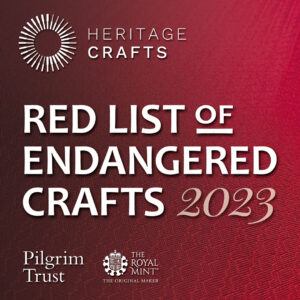 The 2023 edition of the Red List of Endangered Crafts was led by Mary Lewis, Heritage Crafts’ Endangered Crafts Manager, supported by the Pilgrim Trust. The project runs alongside Mary’s work in identifying and developing interventions to improve the prospects of such crafts, funded by Swire Charitable Trust and others.
The 2023 edition of the Red List of Endangered Crafts was led by Mary Lewis, Heritage Crafts’ Endangered Crafts Manager, supported by the Pilgrim Trust. The project runs alongside Mary’s work in identifying and developing interventions to improve the prospects of such crafts, funded by Swire Charitable Trust and others.
For the 2023 edition, 259 crafts have been assessed to identify those which are at greatest risk of disappearing. Of the 146 crafts featured on the Red List, 62 have been classified as critically endangered and 84 as endangered. The remaining 112 are classed as currently viable.
For the purposes of this research, a heritage craft is defined as “a practice which employs manual dexterity and skill at the point of production, an understanding of traditional materials, design and techniques, and which has been practised for two or more successive generations.” The research focuses on craft practices which are taking place in the UK today, including crafts which have originated elsewhere.
Drawing on information such as the current number of craftspeople and trainees, the average age of practitioners, opportunities to learn, and other issues affecting the future of the crafts, including the impact of the energy crisis, the research assesses how likely it is that the craft skills will be passed on to the next generation. From armour making and arrowsmithing to wig making and woodturning, each has been assigned to one of four categories: extinct, critically endangered, endangered or currently viable.
One craft (mouth blown flat glass making) is known to have become extinct in the UK since the publication of the 2021 edition, adding to four more in the last fifteen years (cricket ball making, gold beating, lacrosse stick making, and paper mould and deckle making), with one more (sieve and riddle making) brought back from extinction. At the other end of the spectrum, viable crafts are defined as those for which there are sufficient craftspeople to pass on the craft skills to the next generation, though crafts in the currently viable category face real challenges and require continued monitoring.
The original 2017 Red List, funded by The Radcliffe Trust and led by Greta Bertram, was the first to rank traditional crafts by the likelihood they would survive the next generation, bringing the plight of these skills to national attention.
New crafts for 2023
New critically endangered crafts
Crafts classified as ‘critically endangered’ are those at serious risk of no longer being practised in the UK. They may include crafts with a shrinking base of craftspeople, crafts with limited training opportunities, crafts with low financial viability, or crafts where there is no mechanism to pass on the skills and knowledge.
- Arrowsmithing (reclassified from 2021)
- Bow making (musical, reclassified from 2021)
- Chain making
- Coppersmithing (reclassified from 2021)
- Encaustic tile making
- Hat block making (reclassified from 2021)
- Plume making
- Silk ribbon making
- Straw hat making
- Sussex trug making (reclassified from 2021)
- Whip making (reclassified from 2021)
New endangered crafts
Crafts classified as ‘endangered’ are those which currently have sufficient craftspeople to transmit the craft skills to the next generation, but for which there are serious concerns about their ongoing viability. This may include crafts with a shrinking market share, an ageing demographic or crafts with a declining number of practitioners.
- Bicycle frame making (reclassified from 2021)
- Boat building (traditional wooden boats, reclassified from 2021)
- Canal art and barge painting
- Composition picture frame making
- Cornish hedging
- Fairground art
- Gauged brickwork
- Graining and marbling
- Hand engraving (reclassified from 2021)
- Hand hewing
- Lacquerwork
- Marionette making
- Mechanical organ making
- Pigment making
- Sgian dubh making
- Silk weaving
- Spar making
- Stained glass window making (historic)
- Vardo art and living waggon crafts
About the Endangered Crafts Fund
Heritage Crafts’ Endangered Crafts Fund was set up in 2019 to ensure that the most at-risk heritage crafts within the UK are given the support they need to thrive. The Fund is used to support makers and trainees who wish to develop or share their skills in the crafts that have been identified as being most at risk.
To date, 57 projects have been funded with support from the Pilgrim Trust, the Radcliffe Trust, the Dulverton Trust, Swire Charitable Trust, Sussex Heritage Trust, Allchurches Trust and Garfield Weston Foundation. Anyone wishing to donate to the fund may do so securely online via the web link below. Alternatively, please send a cheque made payable to ‘The Heritage Crafts Association’ with an accompanying note specifying ‘Endangered Crafts Fund’ to: Heritage Crafts, 27 South Road, Oundle, Peterborough PE8 4BU.
About Heritage Crafts
Founded in 2009, Heritage Crafts is a Charitable Incorporated Organisation (CIO) registered as the ‘Heritage Crafts Association’, the advocacy body for traditional heritage crafts. Working in partnership with government and key agencies, it provides a focus for craftspeople, groups, societies and guilds, as well as individuals who care about the loss of traditional crafts skills, and works towards a healthy and sustainable framework for the future. Its aim is to support and promote heritage crafts as a fundamental part of our living heritage.
About the Pilgrim Trust
The Pilgrim Trust is an independent grantmaking trust that supports the urgent and future needs of the UK. It gives approximately £3 million in grants per year to charities and other public bodies that either focus on preserving the UK’s heritage or catalysing social change. Its preservation and scholarship fund aims to preserve the fabric of historically important buildings and to conserve significant collections and artefacts. It wants present and future generations to enjoy the rich and diverse heritage found throughout the UK.
About The Royal Mint
The Royal Mint’s expertise in precious metals spans over a thousand years. Known as the home of precious metals in the UK, The Royal Mint offer products including gold, silver and platinum commemorative coins, bars for investment, and a digital gold saving option, backed by metal held in their vault. Last year they announced plans to build a factory to recover precious metals from electronic waste, currently active at lab level. Recovered metal is being used to create beautiful jewellery pieces in their latest business venture, 886 by The Royal Mint.
A coppersmith, a Highland thatcher and a trainee sailmaker are among the recipients of a new round of grants to help safeguard some of UK’s most endangered craft skills.
 Heritage Crafts has awarded the grants through its Endangered Crafts Fund, which was launched in 2019 to increase the likelihood of at-risk craft skills surviving into the next generation. Five of this round’s grants are funded by The Radcliffe Trust and were selected with special consideration of the impact of the energy crisis on our most vulnerable crafts.
Heritage Crafts has awarded the grants through its Endangered Crafts Fund, which was launched in 2019 to increase the likelihood of at-risk craft skills surviving into the next generation. Five of this round’s grants are funded by The Radcliffe Trust and were selected with special consideration of the impact of the energy crisis on our most vulnerable crafts.
In 2021 Heritage Crafts published the third edition of its groundbreaking Red List of Endangered Crafts, the first research of its kind to rank the UK’s traditional crafts by the likelihood that they will survive into the next generation. The report assessed 244 crafts to ascertain those which are at greatest risk of disappearing, of which four were classified as extinct, 74 as ‘endangered’ and a further 56 as ‘critically endangered’. A new edition will be published on 11 May 2023.
The seven successful recipients are:
- Scot AnSgeulaiche from Perthshire, to train an apprentice in the craft of Highlands and Islands thatching and encourage the use of locally-grown thatching materials.
- Birgit Frietman and Robyn Smith from London, to set up a hub for horn working in London and reduce their carbon footprint by completing more processes in-house.
- James Slaven from Glasgow, to train in sailmaking with Mark Shiner and set up a workshop at the GalGael Trust making and repairing sails and repurposing old sailcloth.
- Steve Hogarth from Derbyshire, to add the skills of leadworking and flint masonry to his steeplejack business, maintaining the usefulness of traditional buildings without the impact of scaffolding.
- Samantha Dennis from Shetland, to catalogue and replicate historical coiled baskets of Shetland and create a market for small crofters to sell locally-grown oat straw.
- John Wills from Northamptonshire, to set up a tinsmithing and coppersmithing workshop that will also provide teaching, using renewable charcoal to heat the traditional soldering coppers.
- Nicholas Konradsen from Lincolnshire, to research and make Lincolnshire bagpipes in a new workshop with more energy-efficient equipment.
These seven projects follow 50 others awarded in previous rounds, covering endangered crafts such as clockmaking, tinsmithing, kiltmaking and many more. Along with The Radcliffe Trust, which has been the major funder in this round, other funders have included The Sussex Heritage Trust, The Pilgrim Trust, The Dulverton Trust, The Swire Charitable Trust and others, as well as individuals who have donated sums from £5 right up to several thousands of pounds.
As usual the fund was oversubscribed, and Heritage Crafts hopes to work with many of the unsuccessful candidates to identify other funding and support opportunities.
Mary Lewis, Heritage Crafts Endangered Crafts Manager, said:
“The current energy crisis means that our craft skills are at more risk than ever before. We are delighted to be working in partnership with the Radcliffe Trust and other funders to address the specific challenges being faced by endangered crafts practitioners at this time.”
View the full list of the 57 grants awarded to date
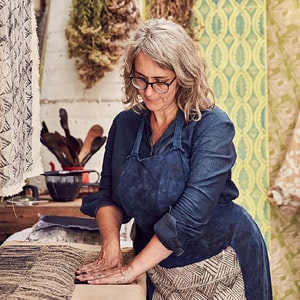 A block printer, a trainee rake maker and a reverse glass sign artist have been awarded grants to help safeguard some of Sussex’s most endangered craft skills.
A block printer, a trainee rake maker and a reverse glass sign artist have been awarded grants to help safeguard some of Sussex’s most endangered craft skills.
Heritage Crafts and the Sussex Heritage Trust have awarded the grants through the Heritage Crafts’ Endangered Crafts Fund, which was launched in 2019 to increase the likelihood of endangered crafts surviving into the next generation. The successful project joins six previous Sussex recipients funded through the partnership between Heritage Crafts and Sussex Heritage Trust, including a trainee millwright, two flint wallers, a brick maker, a trug maker, a wallpaper maker. Nationally, 50 projects have now been funded through the Endangered Crafts Fund since 2019.
The three new recipients are:
- Sarah Burns is a textile block printer and natural dyer from West Sussex. Her craft is founded on the use of seasonal natural dye colours that are foraged from the hedgerows and fields around her – fruitwood prunings in winter, hedgerow cuttings in the spring, fruits and flowers in the summer and warm oak tannins in the autumn. She will use the grant to install two large dye kettles to increase her output and make the business more sustainable whilst upskilling her apprentice.
- Kevin Copeland is Woodland Manager at Veterans’ Growth, a charity in Westfield, East Sussex, dedicated to helping ex-service personnel who are suffering from mental health issues by offering horticultural therapy and support. Kevin will train in traditional wooden rake making in order to pass these skills on to service users and the wider community. Rakes are useful to the charity, as they hand collect the hay from their meadows, and to others in the area who are interested in farming and managing land in a more traditional and sustainable way.
- Eddy Bennett is a reverse glass sign artist from Brighton who uses acid etching to create the distinctive patterns recognisable from Victorian-style advertising signs of the late nineteenth and early twentieth centuries. His grant will enable him to purchase a plotter to cut vinyl etching stencils and provide custom stencils to other reverse glass sign artists in the region.
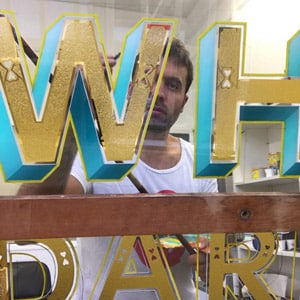 In 2021 Heritage Crafts published the third edition of its groundbreaking Red List of Endangered Crafts, the first research of its kind to rank the UK’s traditional crafts by the likelihood that they will survive into the next generation. The report assessed 244 crafts to ascertain those which are at greatest risk of disappearing, of which four were classified as extinct, 74 as ‘endangered’ and a further 56 as ‘critically endangered’.
In 2021 Heritage Crafts published the third edition of its groundbreaking Red List of Endangered Crafts, the first research of its kind to rank the UK’s traditional crafts by the likelihood that they will survive into the next generation. The report assessed 244 crafts to ascertain those which are at greatest risk of disappearing, of which four were classified as extinct, 74 as ‘endangered’ and a further 56 as ‘critically endangered’.
Mary Lewis, Heritage Crafts Endangered Crafts Manager, said:
“The current energy crisis means that our craft skills are at more risk than ever before. We are delighted to be working in partnership with the Sussex Heritage Trust to address the specific challenges to endangered skills and knowledge in Sussex, a region renowned for its craftsmanship and material heritage.”
A further five grants from the rest of the UK are due to be announced in the coming days.

The Heritage Crafts Awards are now open with six brand new awards for 2023. The Awards, which have been running since 2012, celebrate and highlight the traditional living crafts that contribute to British heritage.
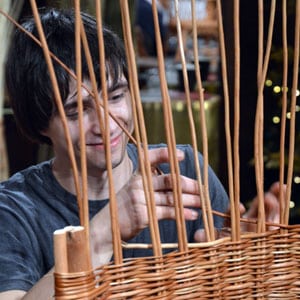 New Awards this year include a new Lifetime Achievement Award supported by the Marsh Christian Trust, to recognise a heritage craftsperson who has demonstrated an outstanding contribution to their specific craft over 25 years or more. The Award celebrates a lifetime’s dedication to a particular traditional skill, resulting in a practitioner operating at the highest level, having made a significant impact on the continued high-esteem in which their craft is held.
New Awards this year include a new Lifetime Achievement Award supported by the Marsh Christian Trust, to recognise a heritage craftsperson who has demonstrated an outstanding contribution to their specific craft over 25 years or more. The Award celebrates a lifetime’s dedication to a particular traditional skill, resulting in a practitioner operating at the highest level, having made a significant impact on the continued high-esteem in which their craft is held.
Heritage Crafts aims to ensure that traditional craft skills are passed to the next generation. For this to become a reality it is vital to celebrate the young people who are embracing craft skills today, already demonstrating excellence and becoming the role models of the future. Therefore we are announcing five new awards for young people 25 and under focusing on woodworking (sponsored by Axminster Tools), upholstery (sponsored by Sonnaz Ltd), weaving (sponsored by Rose Uniacke), basketmaking (sponsored by Sims Hilditch) and metalworking (sponsored by Lucy and Laurence Butcher). We are grateful to all of our sponsors and supporters.
For those not under 25 there are a range of awards to apply for including Maker of the Year, Trainer of the Year, Trainee of the Year and Volunteer of the Year, as well as the Lifetime Achievement Award. There will also be a non-restricted Woodworker of the Year Award opening in June sponsored by Axminster Tools.
Anyone, including the maker themselves, can nominate for this award. The deadline for applications is 5pm on Friday 5 May 2023 and you can find out more about each award, as well as how to apply, at awards.heritagecrafts.org.uk. The award winners will be announced at a high-profile Winners’ Reception at Vicar’s Hall, Windsor Castle, on 15 November 2023.
List of awards open until 5 May 2023:
 The three finalists for the fourth President’s Award for Endangered Crafts, established by Heritage Crafts President The Former Prince of Wales, have been announced.
The three finalists for the fourth President’s Award for Endangered Crafts, established by Heritage Crafts President The Former Prince of Wales, have been announced. 






 The family of the late master hand grinder Brian Alcock have received a posthumous British Empire Medal in the King’s Birthday Honours in recognition of his service to the Sheffield cutlery trade and heritage crafts.
The family of the late master hand grinder Brian Alcock have received a posthumous British Empire Medal in the King’s Birthday Honours in recognition of his service to the Sheffield cutlery trade and heritage crafts. David Poole MBE has been clock maker of the highest standard for over forty years. He has made critical contributions to horological education, establishing remote learning, support and examinations through the British Horological Institute and organising apprenticeships through the George Daniels Educational Trust. Between 2016 and 2019 David set up the Watchmakers Trailblazer Apprenticeship Scheme, one of the first of its kind under the government-backed initiative to promote craft apprenticeships, overcoming many obstacles with devotion and total service.
David Poole MBE has been clock maker of the highest standard for over forty years. He has made critical contributions to horological education, establishing remote learning, support and examinations through the British Horological Institute and organising apprenticeships through the George Daniels Educational Trust. Between 2016 and 2019 David set up the Watchmakers Trailblazer Apprenticeship Scheme, one of the first of its kind under the government-backed initiative to promote craft apprenticeships, overcoming many obstacles with devotion and total service.



 Heritage Crafts has awarded the grants through its Endangered Crafts Fund, which was launched in 2019 to increase the likelihood of at-risk craft skills surviving into the next generation. Five of this round’s grants are funded by The Radcliffe Trust and were selected with special consideration of the impact of the energy crisis on our most vulnerable crafts.
Heritage Crafts has awarded the grants through its Endangered Crafts Fund, which was launched in 2019 to increase the likelihood of at-risk craft skills surviving into the next generation. Five of this round’s grants are funded by The Radcliffe Trust and were selected with special consideration of the impact of the energy crisis on our most vulnerable crafts. A block printer, a trainee rake maker and a reverse glass sign artist have been awarded grants to help safeguard some of Sussex’s most endangered craft skills.
A block printer, a trainee rake maker and a reverse glass sign artist have been awarded grants to help safeguard some of Sussex’s most endangered craft skills. In 2021 Heritage Crafts published the third edition of its groundbreaking Red List of Endangered Crafts, the first research of its kind to rank the UK’s traditional crafts by the likelihood that they will survive into the next generation. The report assessed 244 crafts to ascertain those which are at greatest risk of disappearing, of which four were classified as extinct, 74 as ‘endangered’ and a further 56 as ‘critically endangered’.
In 2021 Heritage Crafts published the third edition of its groundbreaking Red List of Endangered Crafts, the first research of its kind to rank the UK’s traditional crafts by the likelihood that they will survive into the next generation. The report assessed 244 crafts to ascertain those which are at greatest risk of disappearing, of which four were classified as extinct, 74 as ‘endangered’ and a further 56 as ‘critically endangered’.
 New Awards this year include a new Lifetime Achievement Award supported by the Marsh Christian Trust, to recognise a heritage craftsperson who has demonstrated an outstanding contribution to their specific craft over 25 years or more. The Award celebrates a lifetime’s dedication to a particular traditional skill, resulting in a practitioner operating at the highest level, having made a significant impact on the continued high-esteem in which their craft is held.
New Awards this year include a new Lifetime Achievement Award supported by the Marsh Christian Trust, to recognise a heritage craftsperson who has demonstrated an outstanding contribution to their specific craft over 25 years or more. The Award celebrates a lifetime’s dedication to a particular traditional skill, resulting in a practitioner operating at the highest level, having made a significant impact on the continued high-esteem in which their craft is held.
